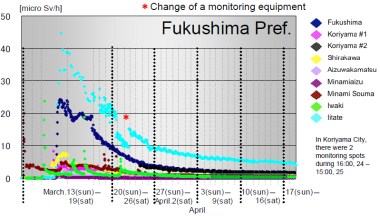ORIGINALLY PUBLISHED: 11.51 GMT
UPDATE 1: 12.57 GMT, Adds graph and info from Edano's press conference
Japanese authorities have decided to revise a marginal portion of the Fukushima evacuation zone and police the area more strictly. The government said the zone is not forced by dose rates within it, but remains a precaution until the plant comes under full control.
Nuclear emergencies were declared after the tsunami of 11 March at both the Fukushima Daiichi and Daini plants, which both lost ultimate cooling functions to sea due to flooding. Evacuation zones were quickly ordered around both, although the situation at the Daini plant was stabilised a few days after the incident began.
Until yesterday the situation was that residents were requested to evacuate within 20 kilometres of Daiichi and to stay indoors in a further ten kilometre radius. For Daini, residents were asked to evacuate within a ten kilometre radius.
However, the Daini plant is only about eight kilometres along the coast, so its ten kilometre evacuation zone overlapped the Daiichi zone apart from one small sector only about two kilometers across at its widest point. Today the Japanese government eliminated this confusion by reducing the Daini plant zone from ten to eight kilometres.
The effect of this is to simplify the overall situation so that it matched the main evacuation order regarding the damaged Daiichi plant. The few residents in the marginal area that has changed now come under instructions to stay indoors at home, rather than to evacuate.
In this morning's press conference chief cabinet secretary Yukio Edano explained that the area covered by the evacuation zone 'has no direct relationship' to dose rates being measured. Some people evacuated from Minami Souma have complained that their home shows very low radiation readings and argued that evacuation was not necessary, but Edano underlined the precautionary nature of the zone.
He said the chance remains that the situation could suddenly escalate and in that circumstance it would not be possible to predict where a potential radiological release would go. For that reason it it prudent to use a system of concentric circles for the evacuation and preparedness orders. "When the plant comes under control, we might consider lifting the evacuation," said Edano, but there is no immediate prospect of this: Although no more radioactive release is likely, Tepco's plan for Fukushima Daiichi forsees another six to nine months before reaching a truly stable condition.
Edano said it is still too early to make a definitive statement on a future compensation plan for affected people. "All I can say is that Tepco will be held liable and they will be made to make full compensation to sufferers of this incident." Insurance would cover some of this, Edano said, but Tepco would have to make full compensation while also maintaining reliable power supplies and "to achieve these goals, government would help Tepco." The company is already paying a provisional amount to people to ease the current inconvenience.
 |
| Radiation levels have been gradually falling since the main releases around 15 March. The highest readings are in Itate village, where dose rates are about 4 microsieverts per hour, compared to normal background radiation in Japan of about 0.25 microsieverts per hour. |
Policing
Tomorrow will see the start of an effort to police the 20 kilometre evacuation zone more effectively, after concerns about residents returning home to check on their homes and belongings.
Apart from a three kilometre zone around of the plant, the area will remain accessible to residents with permission from the chief of local police. The Japanese government said it may impose fines on unauthorised entry.
Other conditions of entry include that only one representative of each family home is allowed to come at once and they must arrive by bus with a companion. They must wear an overcoat carry a radiation meter and transceiver and submit to screening before departure within two hours.
Companies may also send an employee into the zone to check their premises if they can show 'extreme public benefit' from the visit.
Researched and written
by World Nuclear News





_91467.jpg)
_47120.jpg)
_16439.jpg)





